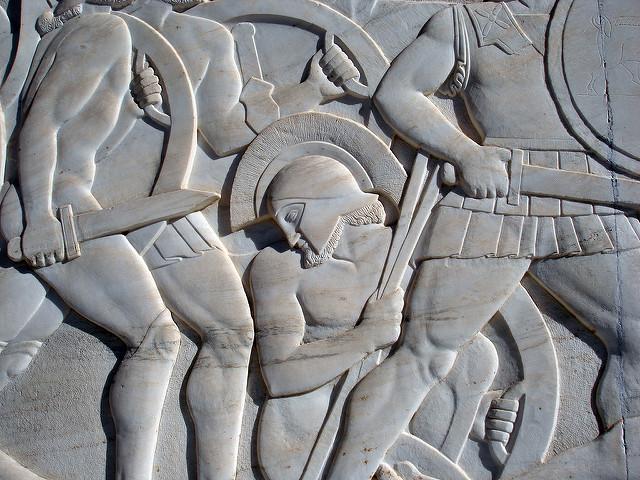
This is a superb book.
John Lewis Gaddis is a distinguished academic at Yale University, occupying the Robert A. Lovett Professorship of History. He’s a strategic thinker of the first order, having won the Pulitzer Prize for a penetrating biography of George F. Kennan, the American diplomat who defined the theory of containment as bedrock US policy in dealing with the Soviet Union.
Gaddis’s new book, On grand strategy, is sweeping in its dimensions and ambitions. He succeeds in forensically examining episodes in human history from the Hellespont to Hue, underlining where strategic imperatives are either achieved courtesy of the matching of ends and means, or destroyed by lack of judgement.
He begins by citing the Greek poet Archilochus, who impressed the brilliant Oxford don Isaiah Berlin with the competing notions of leadership as reflecting the characteristics either of a fox or a hedgehog. Berlin maintained, ‘The fox knows many things, but the hedgehog knows one big thing.’
The contrast, as Berlin described in his book The hedgehog and the fox, was the difference between a single central vision and the pursuit of many ends that may be unrelated and even contradictory.
Gaddis applies this insightful assessment to the Persian Emperor Xerxes crossing the Hellespont in his invasion of Greece in around 480 BC. Xerxes didn’t heed the restraining advice of his counsellor, his uncle Artabanus, who saw the dangers ahead. Xerxes pressed on with his massive army to ultimate defeat and humiliation.
Delayed by the Spartans at Thermopylae, his fleet destroyed by the Athenians at Salamis and finally on land at Plataea, the Persian host began to disintegrate. Gaddis writes:
But Xerxes failed, as is the habit of hedgehogs, to establish a proper relationship between his ends and his means. Because ends exist only in the imagination, they can be infinite: a throne on the moon, perhaps, with a great view. Means, though, are stubbornly finite: they’re boots on the ground, ships in the sea, and the bodies required to fill them. Ends and means have to connect if anything is to happen. They’re never, however, interchangeable.
The recurring theme of the fox and the hedgehog is a useful device that allows Gaddis to unify his narrative. Across a range of military philosophers, major authors and more recent strategic thinkers, Gaddis weaves creativity and imagination into the decision-making which is under examination. From Sun Tzu to Clausewitz, and from Herodotus to Leo Tolstoy (with honourable mentions given to the likes of Machiavelli and St Augustine), Gaddis draws both insight and inspiration from thinkers of consequence.
And repeatedly he asks questions. Perhaps the single most important question is: Why did the Athenians see the need to send the best of their army to fight a war in Sicily?
On Sicily, Syracuse went to war against Segesta, a city allied to Athens. The Segestans sought Athenian intervention, which was duly considered by the Athenian assembly. Gaddis writes eloquently of the Athenian deliberations:
The Athenian assembly had always responded more to emotions than to abstractions, while relying on leaders to cool it off. Now, though, few were left. It dismissed protests from Nicias, the city’s most experienced general, against being dragged into a war ‘with which we have nothing to do.’ It welcomed seduction by Alcibiades, better known for his dazzling looks and Olympics prowess than for his prudence. Sicily’s defenders, this peacock claimed, were a rabble easily bribed. Their defeat would win Athens a western Mediterranean empire. Nor should anyone try to say where its expansion should stop, for ‘if we cease to rule others, we shall be in danger of being ruled ourselves.’
The Sicilian War was a disaster for Athens. The Corinthians intervened, Alcibiades defected to Sparta, and both the Athenian army and their fleet were smashed.
Gaddis draws an intriguing parallel with the US and Vietnam, quoting from a speech by John F. Kennedy on the morning of his death in Dallas on 22 November 1963 to the effect that the US was ‘the keystone in the arch of freedom’ and therefore must defend South Vietnam.
Gaddis consistently demonstrates critical scholarship, persuasive analysis and compelling conclusions. His strategic vision moves across the Roman Empire from the murder of Julius Caesar and the emergence of Octavian as Augustus Caesar, through to the sclerotic rigidity of the Spanish Empire under Charles V, battling to deal simultaneously with challenges from the Ottomans in the East, the Protestants in the Netherlands, and the English under the agile Elizabeth I everywhere from the Channel to the Caribbean.
Napoleon’s catastrophic failure after Borodino is also subjected to rigorous evaluation. Despite battlefield success, Marshall Kutuzov continues to retreat. Moscow is abandoned and then burned. Wonderfully, Gaddis describes Bonaparte as ‘like a dog which has caught the car it has been chasing’.
The critics would argue that On grand strategy reads like a selection of Gaddis’s lectures at Yale. Perhaps—but if so it would have been a privilege to sit through such a rich outline of strategic dilemmas from the ancient world to the 20th century. For anyone working in the field of strategic theory and practice, this book has intrinsic value, and is an essential foundation in arriving at imaginative yet real conclusions.